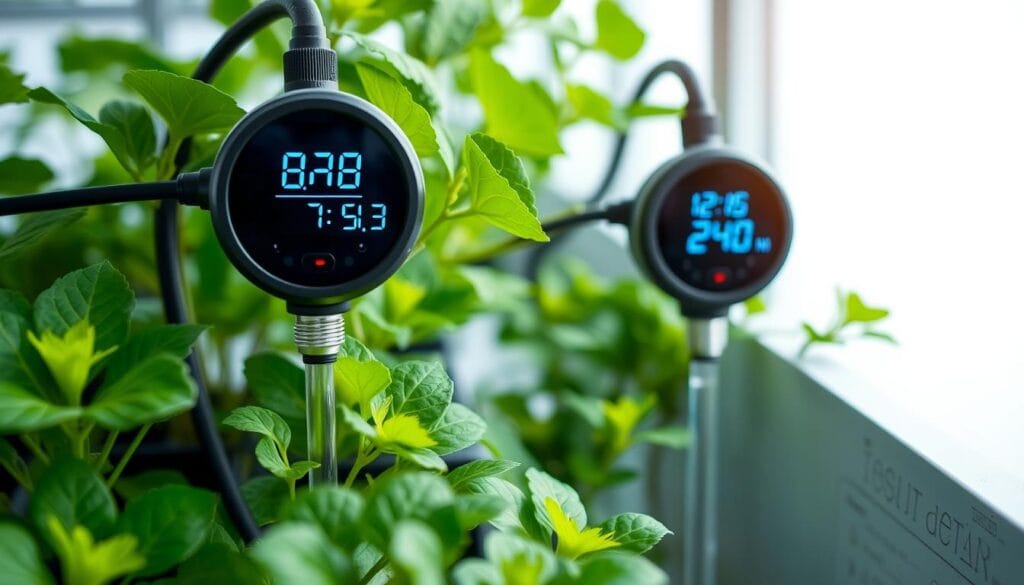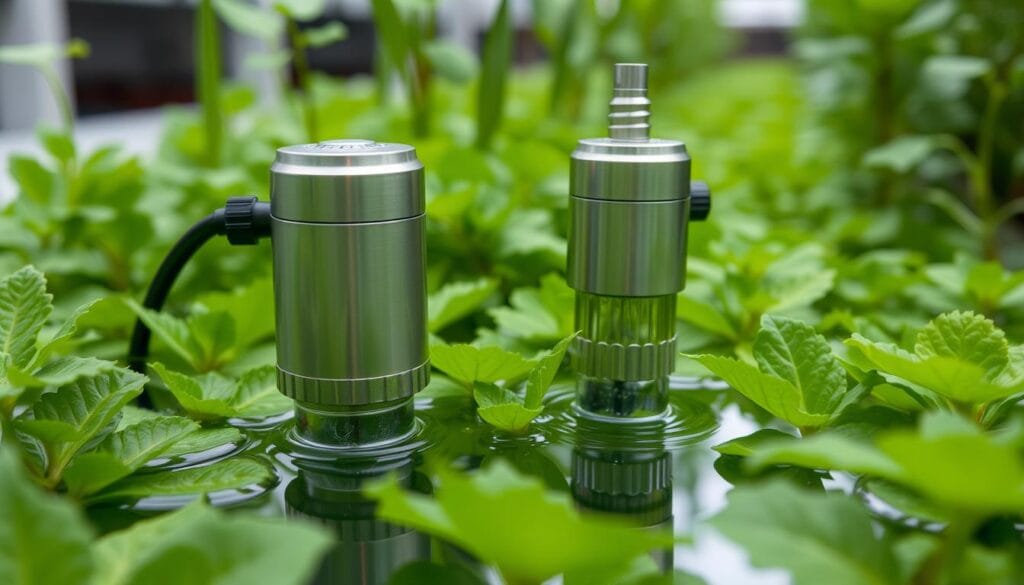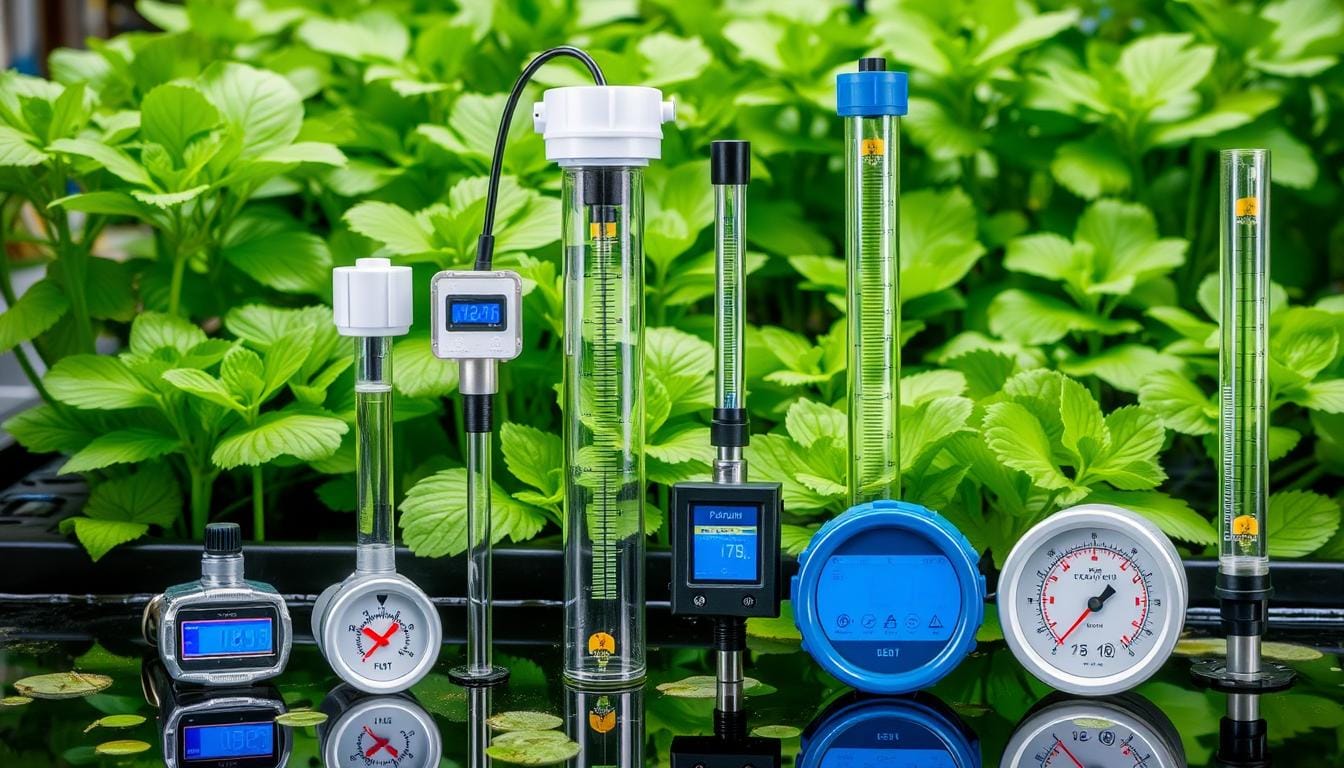Water level indicators for Thriving hydroponic gardens keep the balance in your system. Must say as a hydroponic gardener says: managing the water is the most important thing so that ‘your plants can be healthy and strong ‘.Proper water levels are a prerequisite for successful indoor horticulture. This–is why I have come across 5 water level indicators that will maximize growth and plant health.
Key Takeaways
- Regular monitoring of water levels is essential for maintaining optimal plant growth in hydroponic systems.
- Choosing the right water level indicators can help you precisely control and maintain the ideal water levels for your hydroponic garden.
- Water quality, including pH and TDS levels, should be carefully monitored and maintained to ensure healthy plant development.
- Investing in reliable water level monitoring tools can help you avoid costly plant losses and maximize the productivity of your hydroponic setup.
- Automating water level management through smart controllers and sensors can simplify the gardening process and free up your time.
Understanding Water Management in Hydroponics
Effective water management is key to a thriving hydroponic garden. It involves monitoring water quality and keeping water levels just right. Let’s explore the important parts of water management in hydroponics.
The Role of Water Quality Monitoring
In hydroponics, water quality is crucial for plant growth. It’s important to test and monitor pH, EC, TDS, DO, and ORP regularly. The right pH range of 5.5-6.5 ensures plants get the nutrients they need.
Keeping DO levels between 5-7 ppm helps roots grow strong. Monitoring EC and TDS lets you adjust nutrient levels accurately.
Impact of Water Levels on Plant Health
Water levels greatly affect plant health in hydroponics. TInsufficient water can stress plants, whereas excessive water may lead to root rot. It’s vital to watch water levels and adjust them as needed.
Basic Principles of Hydroponic Irrigation
The success of a hydroponic system relies on its irrigation. Knowing how to manage flow rate, water volume, and delivery is essential. Consider plant size, growth stage, and environment when designing your irrigation system.
Mastering water management in hydroponics leads to healthy plant growth and efficient nutrient use. Keep an eye on water quality and levels, and use smart irrigation to make your hydroponic garden thrive.
Water Level Indicators for Thriving Hydroponic Gardens: Essential Tools Overview
Keeping the right water level is key for a successful hydroponic garden. Thanks to smart gardening tech, we have many tools to help. From simple float switches to advanced ultrasonic sensors, these tools give us the info we need to keep our plants healthy.
The digital pH meter is a must-have for hydroponics. It checks the pH of your nutrient solution, which should be between 5.5 and 6.5 for most plants. Some plants, like blueberries, need a pH between 4.0 and 5.0. Checking pH helps plants absorb nutrients well and stay healthy.
Growers also need to watch the electrical conductivity (EC) or total dissolved solids (TDS) of their water. These levels show how much nutrient is in the water. Special meters can measure EC/TDS, helping you adjust your nutrient solution as needed.
- Digital pH meters offer the most accurate and reliable way to test pH levels in hydroponic systems.
- pH paper and liquid test kits are less precise alternatives to digital meters.
- Common pH adjusters for hydroponics include potassium hydroxide and calcium carbonate.
Some growers also use dissolved oxygen (DO) and oxidation-reduction potential (ORP) sensors. These tools give more info on water health, helping growers tweak their systems for better plant growth.
“By keeping water levels optimal with ultrasonic sensors, plant growth accelerates, plants stay healthier, and water-related problems such as leaks or malfunctioning irrigation systems are detected early.”
Using these smart gardening tools, hydroponic gardeners can manage water levels better. This leads to a thriving, automated irrigation system that boosts yields. Whether you’re new or experienced, these tools can help you get the most out of your hydroponic garden.
Float Switches: The Traditional Solution
In hydroponic gardening, float switches are a trusted tool for water level monitoring. They use a buoyant mechanism to detect water level changes. This triggers actions like turning on pumps or sounding alarms. Float switches are key to keeping your hydroponic plants healthy and growing well.
Types of Float Switches
Float switches come in different designs for various hydroponic systems. The main types are:
- Vertical float switches: These are placed vertically in the reservoir, moving up and down with the water.
- Horizontal float switches: These are mounted horizontally, detecting water level changes through their movement.
- Multi-level float switches: These have multiple float arms that can trigger different actions at different water levels.
Installation and Maintenance Tips
Proper installation and regular maintenance are key for float switches in hydroponic systems. Here are some tips to help:
- Place the float switch at the desired water level for best performance.
- Make sure the switch is securely attached to prevent it from moving or getting dislodged.
- Check regularly for any obstructions or debris that could affect the float’s movement.
- Clean the float and switch parts often to keep them sensitive and responsive.
Advantages and Limitations
Float switches are simple and affordable but have some limitations. Their advantages include:
- Easy installation and setup
- Affordable price
- Reliable in basic hydroponic systems
However, they may not be as precise or responsive as newer technologies like ultrasonic or capacitive sensors. They can also wear out over time, needing more frequent maintenance and replacements.
Understanding float switches is important in hydroponic gardening. They help ensure your plants get the right amount of moisture to thrive.
Ultrasonic Sensors for Precise Measurement
Ultrasonic sensors are a reliable and innovative way to manage water levels in hydroponic gardens. They use sound waves for precise, non-contact water level measurements. This makes them a great choice for many types of hydroponic reservoirs.
These sensors emit sound waves and calculate the time it takes for the waves to return after hitting the water’s surface. This technology lets growers keep a close eye on water levels. It helps plants absorb nutrients better. Plus, ultrasonic sensors don’t have the problems that contact-based sensors do.
When ultrasonic sensors work with automated systems, they get even better. They send real-time water level data. This data helps set up precise irrigation schedules. It prevents plants from getting too much or too little water, helping them grow well.
“Ultrasonic sensors offer a reliable and efficient solution for monitoring water levels in hydroponic systems, ensuring plants receive the ideal nutrient solution and promoting healthy, vibrant growth.”
Many hydroponic growers choose ultrasonic sensors because they are versatile and accurate. They work well with different reservoir sizes and shapes. Also, these sensors are easy to maintain and last a long time, making them popular in the smart gardening technology market.

As more people want efficient and sustainable hydroponic growth, ultrasonic sensors will become even more important. They give precise, real-time data and help manage water automatically. This helps make hydroponic water sensors and smart gardening technology more successful and viable.
Capacitive Sensors: Modern Technology in Action
Capacitive water level sensors are changing hydroponic gardening. They offer precise, reliable, and automated water management. These sensors use electrical properties to detect water levels with great accuracy. By understanding how they work, hydroponic fans can fully use this modern water management.
How Capacitive Sensing Works
Capacitive sensors measure changes in electrical capacitance when water touches them. This change in dielectric properties lets the sensor read the water level. They work with many liquids, fitting different hydroponic setups.
Benefits for Hydroponic Systems
Capacitive water level sensors are great for hydroponic gardening. They resist foam and condensation, working well in moist places. Their accuracy and repeatability help growers keep water levels perfect for their plants. They also work well with automated irrigation systems, helping growers automate water tasks and keep plants healthy.
Setup and Calibration Guide
Setting up and calibrating capacitive water level sensors is important. Follow the manufacturer’s guide for correct placement and connections. Calibration might need adjusting sensitivity or considering tank size and water type. With proper setup and calibration, gardeners get the most from these sensors.
“Capacitive sensors have revolutionized water level monitoring, providing unparalleled accuracy and reliability for hydroponic gardeners.”
Smart Controllers and Automation Systems
In hydroponics, smart controllers and automation systems are changing how growers manage their gardens. These technologies use sensors and controls to watch over your hydroponic setup. They check water levels, nutrient amounts, and pH balance.
By automating these tasks, smart controllers adjust nutrient dosing, pH levels, and irrigation schedules. They do this based on real-time data. This ensures your plants get the right nourishment to grow well.
These smart systems stand out because they use AI algorithms. These algorithms predict when maintenance is needed and optimize growing conditions. This makes your hydroponic system more efficient and boosts crop yields.
With automation, you can focus on other important gardening tasks. You can be sure your automated irrigation systems and smart gardening technology are watching over your plants.
| Feature | Specification |
|---|---|
| SensorDirector | Connects up to 64,000 IoT sensors in series, each module handling up to 4 sensors |
| DryContactDirector | Enables the automation and control of up to 64,000 electrical devices when used in series, with each module managing 4 dry contacts |
| SocketDirector | Permits automating and controlling up to 32,000 electrical devices when used in series, with each smart grow controller handling 2 sockets |
| HydroDirector | Facilitates controlling up to 48,000 dosing pumps in series, each module handling 3 pumps and 3 hydroponic sensors |
| GrowDirector | Smart greenhouse controls communicate via WiFi, enabling easy distribution around the growing operation or greenhouse without the need for centralizing or rewiring existing electrical connections |
These smart controllers and automation systems are easy to scale and install. They offer a plug-and-play setup for easy monitoring and activation. Growers can customize settings, like temperature thresholds for cooling and ventilation.
With real-time data monitoring and remote access, you can manage your hydroponic garden from anywhere. Smart controllers collect data over time. This helps you make better decisions to improve crop yields and growing success.
Optical Sensors and Digital Monitoring Solutions
Hydroponic gardening is getting smarter with new tech. Optical sensors use light to check water levels in your system. They’re more accurate than old methods, giving you up-to-date info on your garden.
Advanced Features and Capabilities
Optical sensors have cool features for hydroponic water monitoring. They can measure water levels and connect to digital tools. This lets you check pH, nutrient levels, and temperature on your phone or computer. It helps you make better choices for your plants.
Integration with Smart Gardens
Connecting optical sensors to smart gardening tech makes managing water easier. You can set up your garden to do things automatically. This saves time and helps you use resources better, making your garden more efficient and cost-effective.
Troubleshooting Common Issues
Even with great tech, problems can happen. Sensors might need to be recalibrated, and things like light or air bubbles can affect them. But, with quick fixes, your system will work well for a long time.
Smart gardening tech is changing hydroponic water management. Optical sensors and digital technologies provide enhanced precision and automation. This leads to healthier plants and a greener future for farming in cities and indoors.
Maintaining and Calibrating Water Level Indicators
Keeping your hydroponic garden healthy is key. You need to regularly check and adjust your water level indicators. This helps keep your system running smoothly and your plants thriving.
For pH and EC sensors, it’s important to check them often. This ensures they’re giving you accurate readings. Ultrasonic and capacitive sensors might need adjustments to stay precise. Keeping a maintenance log and records of repairs is also crucial.
- Clean your water level sensors often to prevent damage from debris.
- Look for any wear or damage on your sensors and replace them if needed.
- Recalibrate your hydroponic water sensors as the manufacturer suggests, usually every few months.
- Do buffer solution checks for pH and EC sensors to confirm their accuracy.
- Adjust the sensitivity of ultrasonic and capacitive sensors regularly for best results.
- Keep a detailed record of all maintenance and calibration to track your system’s health.
By keeping up with your water level indicator care, your hydroponic system will run at its peak. This means your plants will get the best conditions for growth, leading to healthy and vibrant yields.

Real-Time Monitoring and Data Analytics
Smart gardening technology is changing how we care for hydroponic systems. It offers real-time insights into your garden’s health. This helps you make better decisions and improve growing conditions.
Advanced automated irrigation systems use sensors and IoT to track important factors. These include water levels, nutrient levels, pH, temperature, and humidity. With 95% accuracy, your plants get the care they need.
Data analytics takes monitoring to the next level. It analyzes data to spot trends, predict needs, and improve growing strategies. Machine learning helps your system adapt to your plants’ needs.
Real-time monitoring and data analytics offer clear benefits. They cut down on human errors by 30%, saving 30% on water and boosting crop yields by 25%. They also cut energy use by 50%, making your garden more sustainable and affordable.
Whether you have a small garden or a large operation, these tools are powerful. They offer flexible connectivity options like LoRaWAN and NB-IoT. This lets you control your growing environment like never before.
| Metric | Impact |
|---|---|
| Monitoring Accuracy | 95% for water temperature, pH, and nutrients |
| Human-related Errors | Reduced by almost 30% |
| Water Consumption | 30% less |
| Crop Yield | 25% increase |
| Energy Intake | Decreased by 50% |
| Response Time | Alterations to water parameters within 5 minutes |
Use real-time monitoring and data analytics in your hydroponic garden. It’s a new era of smart gardening technology. It boosts efficiency, increases yields, and makes gardening easier.
Conclusion
Water level indicators are key for keeping your hydroponic gardens in top shape. You can choose from float switches to advanced sensors. These tools help your system work better and grow more efficiently.
It’s important to keep these indicators in good working order. Regular checks and adjustments are crucial. This way, your plants get the right nutrients and oxygen, leading to healthy growth.
Whether you’re new to hydroponics or have been growing for a while, good water level indicators are vital. They help you monitor and manage your garden’s water levels. This leads to a thriving, productive hydroponic garden.

